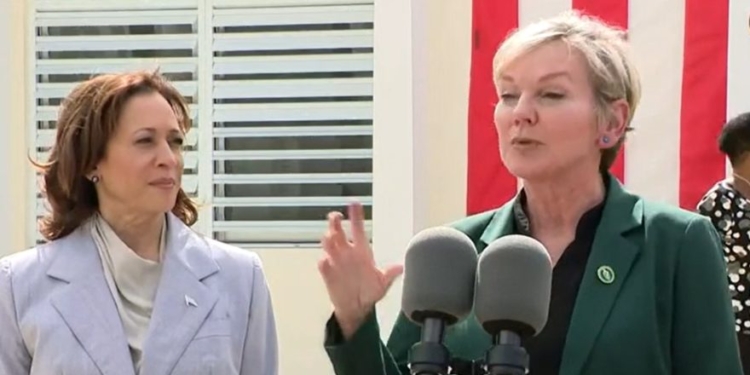In what has been an all-too-rare moment of energy policy lucidity from the current presidential administration, Energy Secretary Jennifer Granholm, in Georgia last Friday to celebrate the opening of Georgia Power Company’s Plant Vogtle Unit 4 nuclear unit, advocated for expanded U.S. investment in nuclear power in the coming years.
Naturally, she couched her remarks in the context of reaching the Biden presidency’s “net-zero by 2050” goal, which BloombergNEF recently said will cost well over $200 trillion globally.
“It is now time for others to follow their lead to reach our goal of getting to net zero by 2050,” Granholm said. “We have to at least triple our current nuclear capacity in this country.”
This is great as far as it goes, especially coming from the authoritarian governing class that has been pouring hundreds of billions of dollars into unpredictable, intermittent power generation sources like wind and solar. Those industries, which have essentially become clients of the Democratic Party in their thirst for a constantly rising suite of federal subsidies in recent years, lack the energy density to truly serve as adequate replacements for coal and natural gas in power generation.
That is a problem nuclear facilities like the Vogtle Plant do not share, but President Biden and his senior political appointees have been largely silent about nuclear power’s potential to help them make progress on their project to cut emissions of plant food, i.e., carbon dioxide.
In addition to its high-energy density, nuclear also emits zero carbon, a fact the Democratic Party has long pooh-poohed in favor of a superstitious fealty to lingering narratives about the dangers of radiation, nuclear waste disposal, and meltdowns that have never taken place.
The party’s supporters in the big conflict groups that make up the climate alarm lobby still rake in millions from gullible donors thanks to their perpetuation of alarm narratives related to the 1979 accident at Three Mile Island, in which no one got a dose of radiation above what they get from microwaving a cup of coffee. A cash cow like that can’t just be discarded, after all, even 45 years after the fact.
So, if Granholm’s glowing remarks signal an administrative change of direction, it would be a welcome development indeed. The fact that the Department of Energy stepped up to the plate in March with a $1.5 billion low-interest-loan guarantee to help fund the restarting of the mothballed Palisades Plant in Granholm’s home state of Michigan is another indicator of a possible change in direction.
Unfortunately, Georgia Power CEO Chris Womack informed the audience at the ceremony they should not expect his company to invest in additional nuclear units anytime soon.
“I think the federal government should provide a leadership role in facilitating and making that become a reality,” Womack said. “We’ve had a long experience, and we’re going to celebrate what we’ve gotten done here for a good little while.”
Womack’s remarks really aren’t surprising, given that the combined up-front cost of the Vogtle 4 Unit, and the Vogtle 3 Unit that went into service last year totaled to $31 billion. The federal government defrayed a small portion of the capital needs through a $12 billion loan guarantee, but raising that kind of scratch is a difficult, time-consuming enterprise.
Like developers of every other energy-related project, nuclear developers also complain loudly about the difficulty and long lead times required to obtain necessary permits from the federal and state governments.
But something will have to give here if the U.S. is going to continue to pursue these Green New Deal goals. With Biden’s quixotic dreams about a massive expansion of offshore wind facilities now foundering on the shoals of the sticky inflation his own programs helped create, and the needed quantum leap in battery storage technology always remaining “just around the corner,” there is a growing consensus that a major expansion of nuclear generation is America’s only viable path to meeting its energy and emissions needs while maintaining grid security and reliability.
Everyone should celebrate if Granholm’s recent positive moves and statements related to nuclear power generation signal a change of direction within the Biden administration writ large. Better to deal with energy reality late than to never deal with it at all.
David Blackmon is an energy writer and consultant based in Texas. He spent 40 years in the oil and gas business, where he specialized in public policy and communications.
The views and opinions expressed in this commentary are those of the author and do not reflect the official position of the Daily Caller News Foundation.
(Featured Image Media Credit: Screen Capture/CSPAN)
All content created by the Daily Caller News Foundation, an independent and nonpartisan newswire service, is available without charge to any legitimate news publisher that can provide a large audience. All republished articles must include our logo, our reporter’s byline and their DCNF affiliation. For any questions about our guidelines or partnering with us, please contact [email protected].



























 Continue with Google
Continue with Google